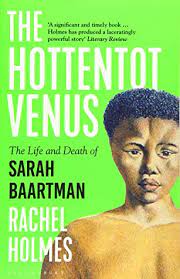The Hottentot Venus: The Life and Death of Sarah Baartman
The book I read for the 2021 NONFICTION READER CHALLENGE in the category Celebrity is The Hottentot Venus: The Life and Death of Sarah Baartman, by Rachel Holmes, 2007. I had heard about this woman many years ago, and her story fascinated me because of how degrading it seemed. She was one of the most famous women in England in the early 19th century mainly because of her large buttocks and the perceived size of her vulva.
Saartjie
Baartman (or Sarah in English) was born in 1789 in the region of the Gamtoos River
Valley in the Cape Colony of South Africa, a member of the Khoisan people,
known in English of the time as Hottentots. She became a servant/slave to a man
who eventually smuggled her to England and functioned as her “manager.”
England
at this time was becoming ever more interested in the exotic animals and people
of Africa and Asia that they heard about through the travels of the explorers
and anthropologists of the era. Baartman was put on display as an ‘exotic’
curiosity and gave a performance that included dancing and playing a ramkie instrument as well as strutting
around in a sheer, form-fitting costume. But most of the show was an
opportunity for the audience to ogle her and even be able to touch, pinch and
grope her for an extra price. It is unclear to what extent Baartman was a willing
participant in this business, considering the alternatives she had at home of
being a worker akin to a slave. But, as Holmes describes the situation she was
in, she didn’t have much choice because she had a “contract” that was similar
to that of an indentured servant. In other words, a form of slavery.
Considering
that there is not a lot of information about this woman before her celebrity
life in England, Holmes has done extensive research using a variety of records
and secondary sources. She gives a lot of background information about the area
and historical events during Baartman’s life in Africa that gives a greater
understanding of the people and attitudes of that time. There are times that
she makes statements that can only be assumptions on her part, but mostly they
make sense, considering the information they are based on. For example, in
relating how Baartman came to be in servitude after her father and fiancée were
murdered, Holmes writes:
“Saartjie
was orphaned, female and unprotected. In what can only be imagined as the most
turbulent and distressing circumstances, she was wrenched from her home,
separated from her remaining family, and taken into the custody of a hunter and
trader named Pieter Willem Cesars, a free black (vryswarte) from Cape Town. How Pieter Cesars came into Saartjie’s
life, she never explained, nor has it yet been discovered.”
I
would say that one can certainly assume that these circumstances were “turbulent
and distressing.”
It
is clear that Holmes has a disparaging view towards the men who took advantage
of her (and earned their money from displaying her) as well as the people who
formed her audiences. It would be rather difficult not to have such a view. Even
after her death in 1815, she was displayed and exploited as an exotic object.
The Museum of Natural History in Paris disarticulated her body and put her
skeleton, body-cast, brain and genitals on public display, where they remained
for more than 100 years. Although the body parts were removed from display in
the 1970s, they were kept in storage at the museum. Holmes writes:
“For
two hundred years, Saartjie’s skeleton was rattled, her dead brain dissected,
her genital matter fingered by inquisitive European men who believed that her
pickled organs held secrets that would reveal the mysteries of the ‘dark
continent’ of African female sexuality. From these lifeless and fragile
remnants of Saartjie’s violated body, scientists manufactured monstrous,
crackpot theories proposing biological racial differences between human groups.
There was, they argued, more than one species in the genus Homo; races could be classified, and ranked in terms of superiority
and inferiority. The motivation was obvious: the desire to justify inequalities
of power.”
Baartman’s
remains were finally returned to South Africa in 2002. There were celebrations
of her return and ceremonies honoring her burial in the region she came from.
She has become a symbol in South Africa of the legacy of colonialism, and the struggle
for gender equality and for cultural reparation. “Addressing so many live
issues in South Africa, Saartjie became a living ancestor,” Holmes writes.
Choosing this book for the Celebrity category was awkward for me since Baartman was a woman who had ‘celebrity’ forced upon her and for an insulting and degrading reason. But her story illustrates the kind of exploitation, sexism, racism and misogyny that dominated her life and still exists for many women in the world.


This sounds like an extraordinary story. I think your reasoning for including it in the celebrity category sounds reasonable. Thank you for sharing your thoughts
ReplyDeleteI'm glad that you agree this was a reasonable choice for the 'celebrity' category. One is not always a celebrity by choice or for a honorable reason!
ReplyDelete